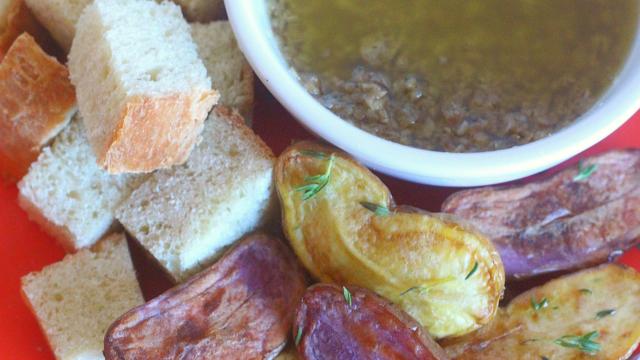Luxury is a tricky concept. Expensive things are often thought of as luxurious, but luxury has less to do with price point, and more to do with time and labour. Though it shouldn’t be, having the time to shop, cook, and feed oneself at a leisurely pace is quite luxurious, as are goods that require a lot of labour or time to source and prepare.
It is easy to make expensive food taste luxurious, but making cheap food taste expensive takes a little more skill, or at least an understanding of which cheap foods are capable of it. Two such foods are garlic and salty fish, which naturally have a lot of flavour. And when gently cooked in olive oil, they form a muddled, melted mass known as “bagna cauda,” and they absolutely scream “luxury.”
It doesn’t look opulent, but don’t let that fool you. Unlike the flashy, brightly coloured foods of summer, bagna cauda is tastefully dull, with an earthy, honest hue that lives somewhere in between brown and grey. It’s all delicious substance, which I think makes it stylish, and it serves more flavour than it has any right to. It’s also exceptionally easy to make.
There are a lot of different recipes out there for bagna cauda. The ingredients are always the same, but the proportions vary, so don’t feel tied to the amounts I list below. I like one can of anchovies and a whole of garlic in mine, but others prefer two cans of fish and less garlic; I obliterate my garlic in the food processor, while others prefer to mince some and slice the rest. Play around and see where you land.
No matter the proportions, you’ll start out by cooking the garlic and anchovies in a bath of olive oil over extremely low heat. Once the little fish have melted and the garlic has mellowed, whisk a little butter in at the last moment to make an aggressively flavorful, savoury, decadent sauce. It’s traditionally eaten as a warm dip with fall vegetables to celebrate the arrival of the season in the Piedmont region of Italy, but it’s pretty delicious on any damn thing. Drizzle it on potatoes, toss it with pasta and a little parm, or shake it with a little vinegar to make a quick salad dressing. To make this absolute luxury of a condiment, you will need:
- 3/4 cup of olive oil
- 10 large cloves of garlic
- 1 can of oil-packed anchovies (should be 12 in one can)
- 2 tablespoons of butter
Heat the olive oil in a small sauce pan over very low heat (I used my lowest setting on my electric stove), and mince your garlic (you can use a knife or pulse it in the food processor; the former will give you a more consistent mince but the latter is faster). Add the garlic and the anchovies to the oil and let cook over low for about 20 minutes, occasionally stirring and mashing with a wooden spoon until the garlic is fragrant and the anchovies have completely melted into the oil. (Be sure to keep the heat very low — you do not want the garlic to brown even a little bit.)
Remove from the heat, whisk in the butter, and serve warm with lots of vegetables (and maybe some bread) for dipping. If you have a fondue pot that keeps things warm by candle, even better. Leftover bagna cauda can be stored in the fridge for up to four days, but I honestly cannot imagine it lasting that long.

Leave a Reply
You must be logged in to post a comment.